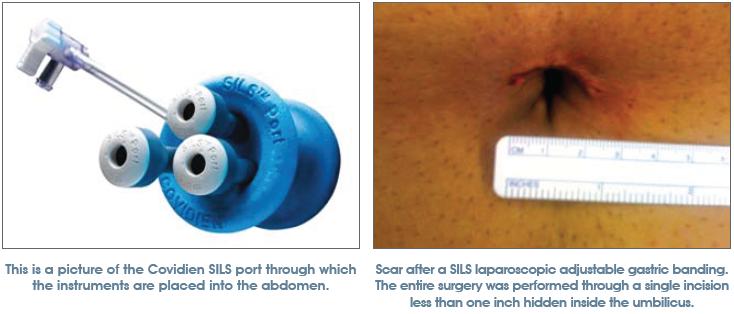Single Incision Laparoscopic Surgery - The newest advances in laparoscopic bariatric surgery
Bariatric Surgery has evolved from open surgery requiring large incisions to laparoscopic surgery requiring five to six small incisions in the abdomen and presently to Single Incision Laparoscopic Surgery (SILS) requiring one small incision hidden inside the umbilicus. The smaller the number and size of the incisions leads to less chance of wound hernias, less chance for wound infections, and less postoperative pain. Laparoscopic surgery is performed by placing a camera inside the abdomen and watching the surgery on a monitor. Instruments are placed through tubes into the abdomen to perform the surgery. Laparoscopic surgery allows for better visualization of the anatomy that is magnified on the monitor.
SILS has become possible because of new instrumentation that allows all of the instruments to be placed through the belly button without banging into each other. A new SILS port has recently been released by Covidien that allows three instruments to be placed into the abdomen through a single device placed into the belly button (See photo).
The two bariatric procedures presently being performed with the new SILS technique are laparoscopic adjustable gastric banding with LapBand AP and with Realize Band and laparoscopic sleeve gastrectomy.
Presently most surgeons using the SILS technique are being very selective in choosing patients for this procedure until their comfort level improves. Patients with a lower BMI, no previous abdominal surgery, female and of shorter stature are the easiest to perform surgery using the SILS technique. As instrumentation and surgeon experience improves, more patients will be candidates for this improved technique.
Care must be taken when choosing a surgeon to perform surgery using the SILS technique. It is important to choose a surgeon with a lot of experience performing these procedures with traditional laparoscopic techniques before attempting to use the SILS technique which is much more challenging. The prospective surgeon should always be asked how many they have performed during your consultation. There is definitely a learning curve to be able to perform this surgery. Be careful and ask how many incisions will be made. Many surgeons are advertising that they perform SILS as a marketing ploy only to later use two or more incisions when they actually perform the surgery. Many surgeons place a liver retractor through a separate second incision. The true definition of SILS is single incision laparoscopic surgery.
The potential advantages of SILS bariatric surgery include:
1) Less post-op pain
2) Quicker recovery: less pain and fewer incisions
3) Better cosmetic results: scar is hidden in the umbilicus
4) Reduced chance of port-site infection
5) Reduced incidence of ventral hernia
6) Reduced incidence of injury related to placement of the tubes or trocars into the abdomen
Stephanie, a 19-year-old female who underwent SILS laparoscopic adjustable gastric banding, stated, ?I am truly impressed by the SILS technique. I had minimal pain from the surgery and took no pain pills since I went home. The best part is that no one will ever know I had surgery. I have no visible scars.? As new techniques and procedures evolve in the field of bariatric surgery it is important for patients to be better educated and to thoroughly research the best doctors to perform their surgery. Sometimes newer procedures lead to more complications until the surgeons overcome their learning curves.

 Shawn Garber, MD, FACS, FASMBS is director of the New York Bariatric Group in New Hyde Park, NY. He is one of only a few surgeons in the Northeast using the new SILS technique for laparoscopic adjustable gastric banding. www.stopobesityforlife.com
Shawn Garber, MD, FACS, FASMBS is director of the New York Bariatric Group in New Hyde Park, NY. He is one of only a few surgeons in the Northeast using the new SILS technique for laparoscopic adjustable gastric banding. www.stopobesityforlife.com
